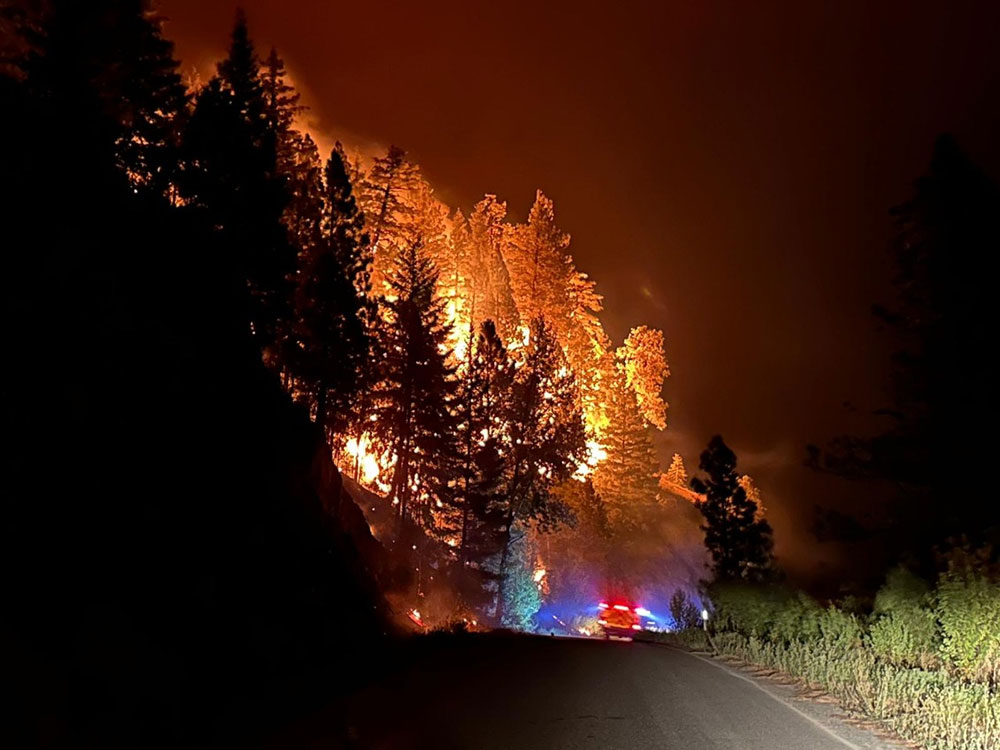Maureen Chapman, co-chair of a review five years ago into disaster management in British Columbia, has watched the destruction of this year’s record wildfires with frustration.
“It’s absolutely devastating,” said Chapman, a Hereditary Chief of the Sq’ewá:lxw First Nation between Agassiz and Hope. “I’d thought working on that report in 2018 that more would have been done to have prevented it being so bad this year. I mean it’s just unprecedented and I’m very frustrated.”
As of Thursday, with the season continuing, 2,025 wildfires had burned about 1.91 million hectares of land, a record for the province and about five times the average for the last 10 years.
The area affected is three times the size of Prince Edward Island and about 50 per cent larger than the 1.2 million hectares that burned in B.C. in 2017, which at the time was a record-setting year.
Following those 2017 fires, which displaced 65,000 people and cost $568 million to fight, the B.C. government appointed Chapman and former BC Liberal cabinet minister George Abbott to conduct a review of how the province manages wildfires and floods.
Their 148-page report "Addressing the New Normal: 21st Century Disaster Management in British Columbia" included 108 recommendations, many of which involved working in partnership with First Nations and communities to better prepare for, prevent, mitigate and respond to disasters.
“It is imperative that we move to a multi-year, multi-pronged approach to community safety — one that involves concerted, proactive investment before emergencies happen,” they wrote.
“The experience of 2017 demonstrated the consequences of ignoring the growing gap between spending in the areas of response versus planning/preparedness and prevention/mitigation. If we are to limit the vulnerability of our homes, our properties and our communities to such extreme weather events and the new normal, the time to reinvest is now.”
Today both Chapman and Abbott say it’s obvious more work needs to be done.
“The challenge hasn’t gone away,” said Abbott, speaking from near Port McNeill where he was on a fishing trip. “If anything I think the challenge has been magnified as increasingly we see symptoms of climate change and it feels to me like a whole lot of factors just come together and put us back on our heels and we’ve certainly been back on our heels this summer. It’s been a very, very difficult fire season.”
A night earlier he’d watched a lightning storm across the Johnstone Strait and been reminded of a pivotal 2017 storm that caused 160 fires in the Cariboo over the space of just a few hours.
“Lightning storms of that nature are something we are going to see increasingly as we see the progression of climate change,” said Abbott. “It puts BC Wildfire in a position where they really can’t address all of that. To me it just underlines we have to think our way through how we’re going to deal with situations like that.”
It is unclear how much work the government completed in response to Chapman and Abbott’s recommendations.
The province released an action plan in October 2018, followed by updates in April 2019 and October 2019. Later it produced a Climate Preparedness and Adaptation Strategy.
According to the most recent publicly available update, by October 2019 the province had completed action on 49 of Chapman and Abbott’s 108 recommendations. It had made a “substantial improvement” on 31 others and had 19 it described as “underway.” On five it had taken an “alternate approach” and there were four that required further analysis or discussion.
Chapman said she doubts how much was really done in response to the recommendations. “I was getting regular reports for the first little while after our report went in, the progress that they were making,” she said. “From government you get this picture of so much more being done than really is.”
Many of the same issues are arising this year as the ones she and Abbott identified in 2017. “I’ve had First Nations from across B.C. reach out and say ‘when are they going to implement the recommendations that were made in that report?’ And I say well, all we can do is present it and hopefully they will.”
Maybe this year’s fires will get Premier David Eby and everybody else’s attention on the fact something different needs to be done, Chapman said, noting “the whole hierarchy and the inability for people to sit down at the same table and talk about things well in advance, like over the winter months, well in advance of the fire season coming.”
Too often government bureaucracy instead gets in the way, Chapman said. “You bump up against these things that cause people to be denied supplies and access. It’s frustrating for me because we did a lot of hard work on that report and I know some things have been implemented, but not enough of them.”
Nor has enough been done to improve communication, she said, noting it’s something she hears from community members and firefighters. “There’s a mechanism in place for them to talk with each other, but I’ve found that people have their turf lines, like ‘this is mine and I’m not sharing this with you,’ and that’s petty compared to human life and people are losing their businesses.”
Chapman said she saw it herself with the devastating 2021 atmospheric river event that caused floods, closed highways and forced people from their homes, including Elders in her community who remain traumatized and still have no homes to go to.
“Nobody’s communicating with us,” she said, adding that getting answers can require navigating through many layers of bureaucracy. “It’s the same thing over and over again. There’s mechanisms in place for that to happen, but they’re stumbling over each other because of their turf, turf wars if you want to call it that.”
A spokesperson for the Ministry of Forests said in an email that all seven of the recommendations in the Chapman-Abbott report that related to communications had been completed and expanded upon. They included updates to websites, improvements to emergency messaging and the creation of communication tool kits for local authorities and Indigenous communities.
Like Chapman, Abbott too stressed the need for all parties to work better together. “As I reflect those recommendations against the 2023 fire season I think the advice that was provided is still sound,” Abbott said. “If anything I feel even more strongly about the critical nature of partnerships in addressing wildfire.”
When you consider the resources it takes to address fires and floods, he said, it’s clear both the federal and provincial governments need to be involved as funders and First Nations and local governments have to be involved in making the best use of the resources.
That’s happening now after disasters happen, but more needs to be done ahead of time, Abbott said, saying there’s still a need to act on the recommendation to apply the United Nations’ Sendai framework for disaster risk reduction, which includes more focus on prevention, mitigation and remediation.
“Just putting out the fires and getting through to September, October when they all go out and we forget about them is not good enough anymore,” he said. “I think we need to be thinking about addressing risks of fire and flood in all seasons of the year.”
The province spends whatever it costs to respond to fires, he said, but commits relatively little to preventing fires and mitigating risk, such as by removing fuel in the interface areas where forests border communities.
It’s advice the government had received before, including in a report by former Manitoba premier Gary Filmon on the 2003 fires in the Okanagan that recommended doing more to reduce risks in places where wildlands border cities, but failed to fully act on.
Abbott said many small communities lack the resources to do the work. “They’re struggling to keep up with street lighting and water and sewer and waste management and recreation and 50 other things. They don’t have large dollars to put into the often quite daunting interface areas that they have around their communities.”
It will take more dedicated funds from the provincial and federal governments to make it happen, he said.
During an Aug. 23 media briefing, Forests Minister Bruce Ralston said the government created the FireSmart program in response to Filmon’s recommendations to remove potential fuel in interface areas. “In some parts of the province it's been taken up very substantially,” he said, giving Kelowna as an example of where it had made a difference.
“The uptake has probably not been what we'd hoped for,” Ralston said. “The funding is there. It just simply, I think, hasn't been taken up. I think people sometimes think that these are not essential programs; these are makework programs. They're the very opposite of that. They can be the difference between successfully extinguishing a fire and seeing a fire go on to profoundly damage a community.”
He said other communities and landowners are encouraged to take advantage of the program.
Ralston acknowledged there had been much discussion following the Filmon report, as well as the Chapman-Abbott report. “I think sometimes the challenge is execution,” he said, “but I sense that municipalities and the public, particularly after this fire season, will be much more disposed to talk about these and welcome the efforts and their opportunity to participate as citizens, as volunteers, as companies, as businesses in the work of fire prevention and general response to disasters.”
He added, “We're going to have to rethink our responses in a profound way, and our government is committed to doing that.”
Abbott said the best outcome of this year’s record fires would be for British Columbia and Canada to sign an agreement that would become a model for other provinces and territories to apply the principles of the United Nations’ Sendai framework to disaster management.
“The tragic events themselves have not concluded, but what I’m seeing is a fair bit of finger pointing and I don’t think that’s very constructive,” he said. “What we need is a realistic appreciation of the magnitude of the challenge that’s ahead, not just in B.C. but in many corners of Canada.”
Chapman said the only path to a solution is through working together. “Governments, communities, everybody just needs to come to the table and solve problems instead of creating more problems,” she said. “They need to start planning right now for next year. They need to meet through the winter, not forget about it. Make it a priority because it’s going to happen again.” ![]()
Read more: BC Politics, Environment

















Tyee Commenting Guidelines
Comments that violate guidelines risk being deleted, and violations may result in a temporary or permanent user ban. Maintain the spirit of good conversation to stay in the discussion and be patient with moderators. Comments are reviewed regularly but not in real time.
Do:
Do not: